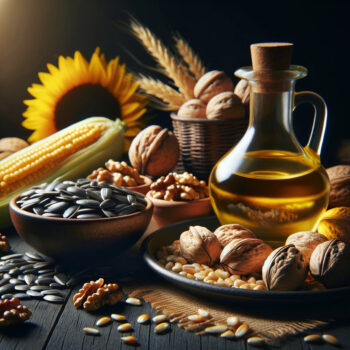 April 30th, 2024
April 30th, 2024
Contributing writer for Wake Up World
Fats — which are water-insoluble biological molecules also known as lipids1 — are the primary building block of your cell membranes. This is one of the reasons why eating the right types of fat is so important for your health and longevity.
Well, after three grueling rounds of peer review over the last three months, my paper on the hazards of linoleic acid (LA), an omega-6 polyunsaturated fat (PUFA), is now published in the high impact Nutrition journal Nutrients and available for free download, here.2
Please download the article and save it on your hard drive as you never know what will happen with a future crisis. You can send it to doctors who don’t yet believe how dangerous seed oils are, but truthfully, the video above is likely better for your friends.
[pro_ad_display_adzone id=”110028″]
I couldn’t have done it without my co-author Dr. Chris D’Adamo who skillfully and diplomatically helped to navigate the minefield of peer review. Our next paper will likely be on reductive stress which is one of the most important foundational and unknown concepts in health. It helps explains why LA is so devastating to your health at a molecular biological level.
Lowering your LA is the single most important strategy you can take to not only lower reductive stress in your mitochondria, but improve your overall health. It took me over six months to create the video above and I would strongly encourage each of you to watch is several times so you embed in your brain how important avoiding LA is for your long-term health so you can develop unconscious reflex behaviors to avoid this pernicious fat.
Fatty Acid Basics
What distinguishes one fat from another is the specific combination of fatty acids it’s composed of, and the properties of fats and fatty acids depend on their hydrogen saturation and the length of their molecules, also referred to as “chain length.”
There are two basic types of fatty acids, based on how many of their carbon bonds are paired with hydrogen:3
- Saturated fats are fully loaded with hydrogen atoms forming straight chains, and are typically solid at room temperature (examples include butter and coconut oil)
- Unsaturated fats have lost at least one of the pairs of hydrogen atoms from their carbon chain and come in two varieties:
- Monounsaturated fats, which are missing one pair of hydrogen atoms
- Polyunsaturated Fats (PUFAs), which are missing more than one pair of hydrogen atoms, hence the name “poly”
The loss of hydrogen results in molecules that kink or bend at each double bond. The more hydrogen pairs that are missing, the more bent the molecules, which causes the molecules to occupy more space. This is what makes the fat a liquid oil at room temperature.
In addition to varying levels of hydrogen saturation, fats also vary in the length of their carbon chains, leading to another classification scheme based on their number of carbon atoms:4
- Short-chain fatty acids (SCFAs) — Two to four carbon atoms
- Medium-chain fatty acids (MCFAs) — Six to 10 carbon atoms
- Long-chain fatty acids (LCFAs) — 12 to 26 carbon atoms
- Very-long-chain fatty acids5 (VLCFAs) — 26 to 30 carbon atoms
The chain length and hydrogen saturation level control a fat’s melting point. As chain length increases, melting point increases. Likewise, fats that are solid at room temperature (butter, coconut oil) have longer chain lengths than fats that are liquid at room temperature (fish oil, olive oil). With chain lengths being equal, the polyunsaturated fats found in seeds oils have lower melting points than saturated fats.
Omega-3 and Omega-6 Basics
PUFAs can also be subdivided into omega-3 and omega-6 fats. The end of the fatty acid chain that is opposite the acid end is the “omega end.” The location of the first double bond from the omega end dictates whether a fatty acid is an omega-3, omega-6, omega-9 (oleic acid) or another member of the omega family.
The most pernicious toxin in the modern diet, and the fat you need to minimize consumption of, is the omega-6 fat linoleic acid (LA). LA makes up 60% to 80% of omega-6 fats and is the primary contributor to chronic disease.
To be clear, it’s only toxic when consumed in excessive quantities, but the vast majority of people nowadays consuming far more than the ideal amounts. The history of how seed oils ended up replacing far healthier animal fats is detailed in the video above.
Many still believe that if you have a distorted omega-3 to omega-6 ratio, the solution is simply to consume more omega-3, but that’s a serious mistake. While you certainly need a certain amount of omega-3s for good health, adding excessive omega-3s is a prescription for disaster, as omega-3 is also a PUFA.
So, when consumed in excessive quantities, omega-3 will cause metabolic damage similar to that of LA, as it breaks down into dangerous metabolites known as ALEs (advanced lipoxidation end products).
Commonly Confused Fats
It is also important to highlight a primarily plant-based omega-3 fat called alpha linolenic acid (ALA). ALA should not be confused with LA, as they are quite different from a biological standpoint. LA is an omega-6 fat and ALA is an omega-3 fat.
Also, do not confuse LA with CLA (conjugated linoleic acid). Although CLA is an omega-6 fat and most think CLA and LA are interchangeable, they’re not. CLA has many potent health benefits and will not cause the problems that LA does.
The Problem With PUFAs
As a general rule, vegetable and seed oils are high in PUFAs and low in saturated fats while animal fats are the converse. Saturated and monounsaturated fats are more easily used by your body than PUFAs, hence animal fats are generally healthier than seed oils.
Because your tissues are made up mostly of saturated and monounsaturated fats, your body also requires more of them than PUFAs. The main dietary PUFAs are omega-3 and omega-6 fats, and while your body does need these, it needs them in relatively small quantities.
One significant problem with PUFAs is that they are chemically unstable, which makes them highly susceptible to being damaged by oxygen species generated from the energy production in your cells. This damage causes them to form ALEs, which in turn generate dangerous free radicals that damage your cell membranes, mitochondria, proteins and DNA.
What’s worse, PUFAs are integrated into your cell membranes and can remain so for five to seven years. The missing hydrogen atoms also make PUFAs highly susceptible to oxidation, which causes the fat to break down into harmful metabolites such as OXLAMs (oxidized LA metabolites), which have a profoundly negative impact on your health.
LA Is Not an ‘Essential’ Fat
“Essential fatty acids” (EFAs) is a term referring to the PUFAs that scientists believe are crucial for health and that your body cannot produce. Hence, you have to get them from your diet. Currently only two types of fats are considered “essential”:
- Omega-3 (EPA, DHA, and ALA)
- Omega-6 fat (LA)
The inclusion of LA is unfortunate, as excessive amounts of LA actually wreck your cellular and mitochondrial function. The reality is you need very small amounts of LA, and because it’s found in most foods, it’s virtually impossible to become deficient. Moreover, modern research has shown that up to 10 generations of animals can be raised without any LA in their diet whatsoever and remain perfectly healthy.
Research has also shown that when you have a large amount of LA in your diet, an enzyme called delta-desaturase — which converts the plant-based omega-3 fat, ALA, to the long-chain fats DHA and EPA — is inhibited. So, consuming high amounts of LA increases your dependence on sea food as a source of preformed EPA and DHA.
This is important, as DHA and EPA are indeed essential and provide a wide range of health benefits. One of the most important benefits of DHA is lowering inflammation, which is a factor in most chronic and degenerative diseases. EPA, meanwhile, is important for heart and cardiovascular health.6,7
Seed Oils Are the Root of All Chronic Diseases
The video above reviews the health risks associated with vegetable oils and seed oils, which are found in most processed foods. It shows how chronic diseases such as heart disease began to skyrocket after the introduction of these oils to the market.
Before 1866, the Western world for the most part only consumed animal fats. Tallow, suet, lard and butter are examples of these fats. Eastern societies used cold-pressed fats like coconut and palm oil. Vegetable oils like we know them today simply did not exist.
The single-greatest change to the human diet in all of history was the introduction of industrially processed seed oils around 1866.8 At that time Procter & Gamble used a newly invented hydrogenation process to convert surplus unusable cotton seeds into a synthetic seed oil, sold to this day under the name Crisco.
Shortly after that, margarine, which is made from seed oils, was introduced. In recent years the company has largely converted to using palm, soy and canola oil for its Crisco, but cottonseed oil is still very much in use for cooking, especially in restaurants for their fryers.9
Historically, we can see that seed oil use increased from approximately 2 grams per day in 1865, to 5 grams per day in 1909, to 18 grams a day in 1999. As of 2008, the average consumption was 29 grams a day. In terms of percentages, seed oils accounted for approximately 1/100th of total calories in 1865 and increased to more than 1/4th of total calories by 2010 — a 25-fold increase!
Seed Oils Are Far Worse Than Sugar
[pro_ad_display_adzone id=”110030″]
While most nutritional experts blame the epidemic of chronic disease on the increase in sugar consumption, the role of sugar is relatively minor when compared to the impact of seed oils.
In 1822 the average U.S. sugar consumption was 6 pounds per person per year. This rose to a high of 108 pounds per person per year by 1999.10 This is a 17-fold increase, but seed oils went up 25-fold during that same time period.
In the 1960s and ‘70s,11 cardiologist Dr. Robert Atkins was largely responsible for creating the interest in low-carb (low-sugar) diets that seemed to work for many. However, eliminating foods like french fries, potato chips, breads, pasta, pizza and donuts not only eliminates sugar-based carbs, but also seed oils. It is not intuitively obvious, but the carb-loaded foods his diet eliminated are also loaded with dangerous refined seed oils.
Processed foods typically contain about 21% sugar. However, up to 50% or more of the overall calories contained in most processed foods come from seed oils.12,13 The connection is further confirmed by looking at the U.S. carb consumption. It’s been declining since 1997, yet obesity and Type 2 diabetes have steadily increased. Interestingly, this continued rise coincides with the surge of seed oil consumption.
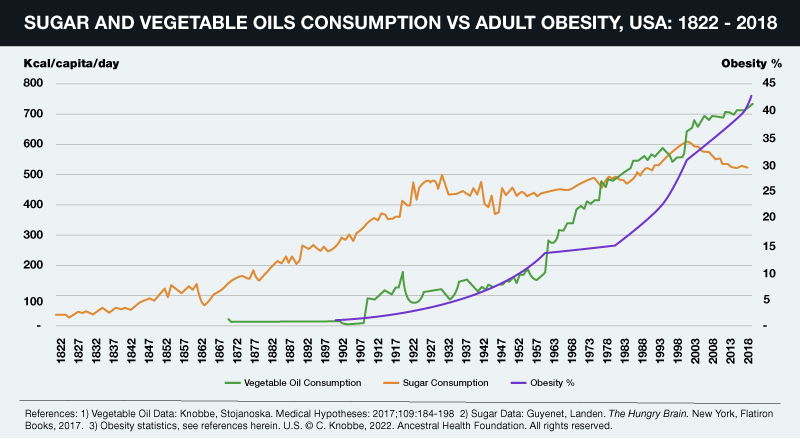
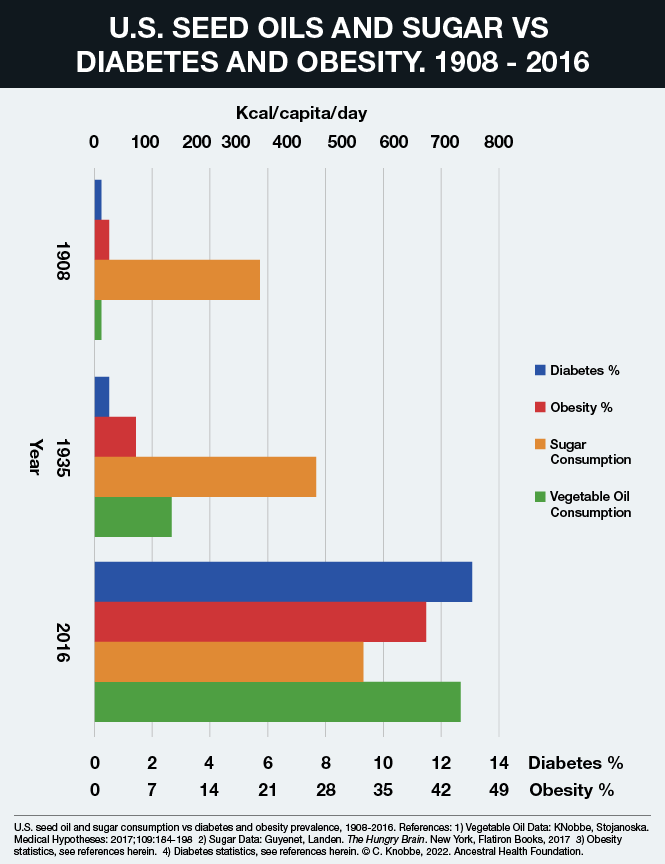
Another major reason why seed oils are exponentially more pernicious to your health than sugar is that they last much longer in your body. The half-life of LA is around 600 to 680 days, or approximately two years. This means it will take you about six years to replace 95% of the LA in your body with healthy fats. This is the primary reason for keeping your LA intake low as possible.
Meanwhile, your glycogen stores will be exhausted in about one to two days. So if you go on a sugar binge, that sugar doesn’t stick around for years destroying your health like the LA in seed oils does.
How Excess LA Consumption Can Wreck Your Health
The main reason why excess LA causes disease is that it prevents your mitochondria from working well. Mitochondria are subcellular organelles responsible for producing most of your cellular energy in the form of ATP, and without ATP, your cells cannot function and repair themselves normally.
As mentioned earlier, PUFAs such as LA are easily damaged by oxygen in a process called oxidation,14 which triggers the creation damaging free radicals.15 These, in turn, give rise to ALEs16 and in the case of omega-6 fats, OXLAMs.17,18
These ALEs and OXLAMs then go on to cause mitochondrial dysfunction, which is a hallmark of most all chronic disease. In addition to oxidation, inflammation and mitochondrial dysfunction, processed seed oils can also:
| Damage the cells lining your blood vessels |
| Cause memory impairment and increase your risk of Alzheimer’s disease (canola oil, in particular, has been linked to Alzheimer’s) |
| Strip your liver of glutathione thereby lowering your antioxidant defenses |
| Inhibit delta-6 desaturase (delta-6), an enzyme involved in the conversion of short-chained omega-3s to longer chained omega-3s in your liver |
| Impair your immune function and increase mortality |
| Make your fat cells more insulin sensitive, thereby causing insulin resistance |
| Inhibit cardiolipin, an important fat in the inner membrane of your mitochondria |
The Importance of Cardiolipin
The inhibition of cardiolipin in the inner membrane of your mitochondria explains much of the damage caused by LA. You have about 40 quadrillion to 100 quadrillion mitochondria throughout the cells of your body. The cristae of the inner membrane of the mitochondria contains a fat called cardiolipin,19 and its function is dependent on the type of fat you get from your diet.
Cardiolipin is important because it influences the structure of the cristae inside your mitochondria, which is the area where energy production occurs. If cardiolipin is damaged, then the complexes will not be close enough together to form supercomplexes and thus the mitochondrial energy production will be impaired.
Cardiolipin also works like a cellular alarm system that triggers apoptosis (cell death) by signaling caspase-3 when something goes wrong with the cell. If the cardiolipin is damaged from oxidative stress due to having too much LA, it cannot signal caspase-3, and hence apoptosis does not occur.
As a result, dysfunctional cells are allowed to continue to grow, which can turn into a cancerous cell. The type of dietary fat that promotes healthy cardiolipin is omega-3 fat, and the type that destroys it is omega-6, especially LA.
The image below illustrates a typical mitochondria on the left. Figure C shows how the folds cause cardiolipin to provide the curve in the mitochondrial cristae. The folding causes the super complexes in the electron transport chain to get closer together and more efficiently transfer electrons to produce ATP.

The good news is that dietary changes can improve the composition of fats in your cardiolipin in a matter of weeks, or even days. So, even though it will take years to lower your total body burden of LA, you will likely notice improvements well before then.
LA Contributes to Heart Disease and Cancer
Heart disease and cancer are two of the primary killers in the Western world, and LA is a significant contributor to both of these lethal conditions. One of the first things that happens in atherosclerosis, which is the precursor to heart disease, is that your macrophages (a type of white blood cell) turn into foam cells — essentially a macrophage stuffed with fat and cholesterol.
Atherosclerotic plaque is basically dead macrophages and other types of cells loaded with cholesterol and fat. This is why heart disease is blamed on saturated fat and cholesterol. However, researchers have found that for foam cells to form, the LDL (low density lipoprotein cholesterol) must be oxidized, and that is precisely what seed oils do.
Seed oils cause the LDL to oxidize, thereby forming foam cells. So, LDL in and of itself does not initiate atherosclerosis. LDL’s susceptibility to this oxidative process is controlled by the LA content of your diet. Excess PUFAs also make cell membranes more fragile, allowing them to be easily damaged by oxidation.20,21
Seed oils are also a major contributor to cancer. In fact, a surefire way to induce cancer in many animal models is to feed them seed oils. Animals typically develop cancer once the LA in their diet reaches 4% to 10% of their energy intake.
And, as mentioned, most Americans get approximately 25% of their total daily calories from seed oils, so we’re far over the safety threshold for these fats — at least based on the laboratory work in animals. Remember our ancestors typically got less than 2% of their calories in the form of omega-6.
There’s even evidence showing that eliminating seed oils from your diet will dramatically reduce your risk of sunburn and lower your risk of skin cancer,22,23,24 as susceptibility to UV radiation damage is controlled by how much LA is in your diet.25,26
What Foods to Avoid, and How
Primary sources of LA include seed oils used in cooking, processed foods and restaurant foods made with seed oils, condiments, seeds and nuts, most olive oils and avocado oils (due to the high prevalence of adulteration with cheaper seed oils), and animal foods raised on grains such as conventional chicken and pork.
Ideally, consider cutting LA down to below 7 grams per day, which is close to what our ancestors used to get. If you’re not sure how much you’re eating, enter your food intake into Cronometer — a free online nutrition tracker — and it will provide you with your total LA intake.
Cronometer will tell you how much omega-6 you’re getting from your food down to the 10th of a gram, and you can assume 90% of that is LA. Anything over 10 grams of LA is likely to cause problems. Healthy fat replacements include tallow, butter or ghee, all of which are excellent for cooking.
The table below provides a fairly comprehensive list of the most commonly consumed oils and their approximate LA content.27,28,29 In general, the lowest LA-containing fats — butter and beef tallow — would be the fats of choice. These excellent cooking fats would not only be the lowest in LA, but will also provide the fat-soluble vitamins, A, D, and K2. Coconut oil is also very low in LA but doesn’t provide the important fat-soluble vitamins that tallow and butter contain.
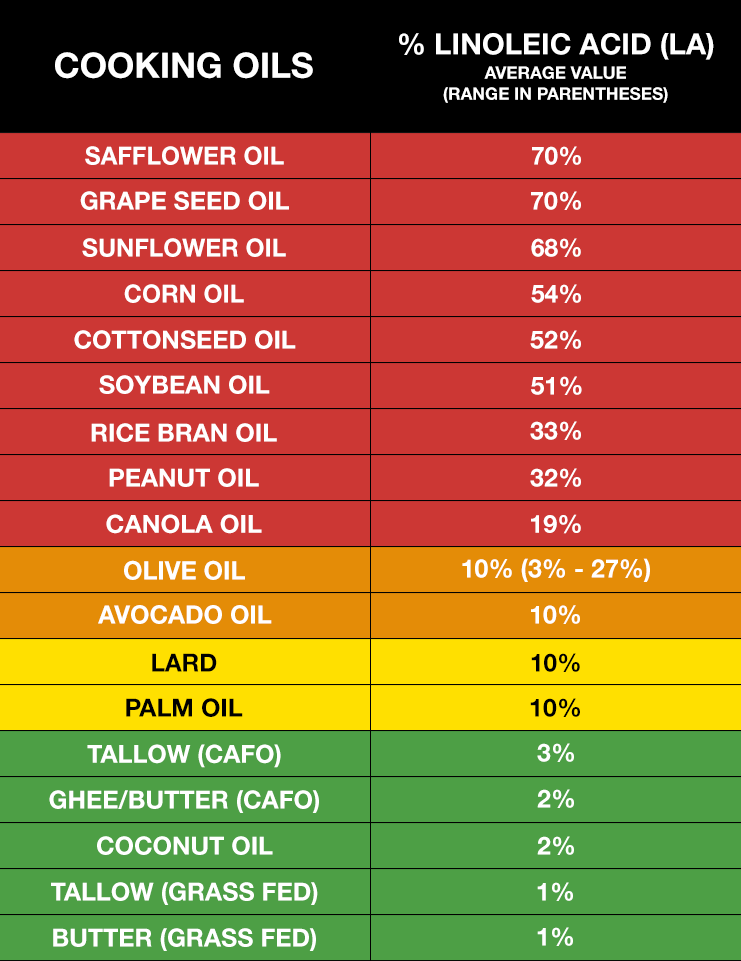
Vast Majority of Olive Oil and Avocado Oil Are Adulterated
Most people introduced to the topic of omega-6 toxicity have questions about olive oil and avocado oil. Consumption of olive oil has increased more than 10-fold in the U.S. over the past 35 years.30 Olives and olive oil are well-known for their many health benefits, especially for your heart, but using adulterated olive oil will not do your health any favors.
Tests have revealed that anywhere from 60% to 90% of the olive oils sold in American grocery stores and restaurants are adulterated with cheap, oxidized, omega-6 vegetable oils, such as sunflower oil or peanut oil, or nonhuman-grade olive oils, which are harmful to health in a number of ways.31
This is even true for “extra virgin” olive oil Cheap seed oils are added and will not be listed on the label, nor will most people be able to discern that their olive oil is not 100% pure. Chances are, you’ve been eating poor-quality olive oil so long — or you’ve never tasted a pure, high-quality olive oil to begin with — you don’t even realize there’s something wrong with it.
The same applies to avocado oil. Many believe avocado oil is as healthy as olive oil, but this is simply not the case. A 2020 study showed that 82% of avocado oil is adulterated, mislabeled or of poor quality.32
In general, people believe the U.S. Food and Drug Administration is policing and regulating food fraud, but that’s not the case. Its primary focuses are making sure the ingredient label is accurate and tracking food-related disease outbreaks.
The FDA does little in terms of preventing illegally adulterated foods from being sold. This makes discerning quality a difficult task, and unless you can somehow ensure you’re getting 100% pure, unadulterated olive oil and/or avocado oil, you’re better off avoiding them altogether.
Go Easy on the Nuts and Seeds
Most people who are interested in health believe that nuts and seeds are “heart healthy” staples.33 However, as you can see in the table below, most nuts and seeds are exceedingly high in LA. For example, 50% of the fat in pecans is LA.34 The only exception is macadamia nuts.
So, while nuts and seeds are often unprocessed and are the best type of omega-6 fats to eat, they will still contribute to the LA content of your diet, and once you hit 5 grams of LA per day, the perishable double bonds will begin to oxidize and generate dangerous free radicals that lead to health problems.
So, nuts and seeds need to be significantly minimized or even eliminated if you want to lower your LA. As mentioned, the exception to this rule is macadamia. Since only 2% of their fat is LA, you can have 10 to 30 a day without significantly raising your LA level.
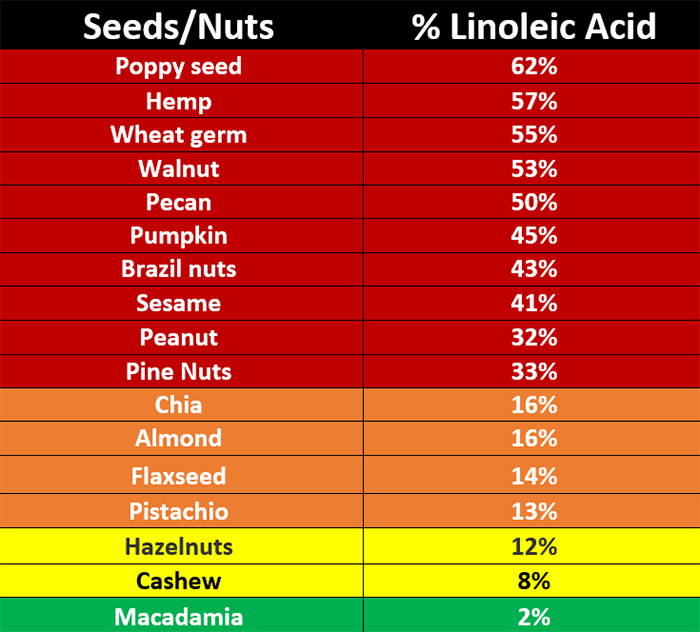
LA in Animal Foods
While seed oils are a primary source of LA, a number of animal foods you might not suspect are also loaded with this harmful fat. Ruminant animals such as cows, buffalo, sheep, lamb, goats, deer, elk and many other game animals have low LA content in their milk and meat, no matter what they eat, thanks to the fact that they have multiple stomachs with bacteria that can convert the high LA fat they eat into saturated and monounsaturated fats.
Animals with a single stomach, however, like chickens and pigs, cannot make this conversion. So, when they’re fed corn and soy, which are high in LA, their meat and eggs will also be high in LA.35 Most chicken and pork have over 25% LA. Chicken eggs are acceptable, though, as each egg has less than 1 gram of LA, and that is assuming they are fed commercial feeds that are loaded with high LA.
Interestingly, the difference in LA in ruminants that are 100% grass-fed and those that are fed corn and soy is only about 0.5%, which is why, from an LA perspective, there isn’t much difference between conventional beef and grass fed-only beef. That said, grass fed beef is still preferred as it typically has less glyphosate and hormones.
So, in summary, your best option is to get most of your animal protein from ruminants and avoid or limit all chicken and pork. My favorite meats are bison and lamb, but any of the ones listed above will work. Ideally it should be organic and the animals should not be fed any food that is contaminated with glyphosate or other pesticides.
LA in Seafood
Ideally, you’d get your omega-3s from healthy seafood. However, not all seafoods contain omega-3s. Only fatty, cold-water fish do. Examples include wild-caught Alaskan salmon, sardines, anchovies, mackerel and herring.
Farmed fish, especially farmed salmon, is best avoided altogether due to the exaggerated potential for contamination. At first glance, farmed fish may seem like a good idea to help protect wild seafood populations from overfishing, but in reality, the industry is plagued with many of the same problems surrounding land-based concentrated animal feeding operations (CAFOs), including pollution, disease, toxicity and inferior nutritional quality.
Most farmed fish are fed genetically engineered (GE) corn and soy, which are a completely unnatural diet for marine life and are loaded with hazardous omega-6 fats. Others are fed fishmeal, which is known to accumulate industrial chemicals like PCBs and dioxins.
From a nutritional perspective, farmed salmon also have the drawbacks of containing only half the omega-3 of wild salmon,36,37,38 and one-fourth the vitamin D,39 while having more than 5.5 times the amount of omega-6.40,41 Farmed salmon are also routinely exposed to antibiotics and pesticides.
Carnosine Can Help Reduce LA-Induced Oxidative Damage
While your body will slowly eliminate stored LA over time, provided you reduce your intake, a peptide supplement called carnosine can help reduce the oxidative damage caused by LA while your body is cleaning itself out.
Carnosine is a dipeptide your body makes and it consists of two amino acids, beta-alanine and histidine. It serves as a sacrificial sink for reactive oxygen species (ROS) and ALEs, meaning it lets these very damaging molecules destroy it rather than your mitochondria, DNA or proteins, as depicted in the image below.
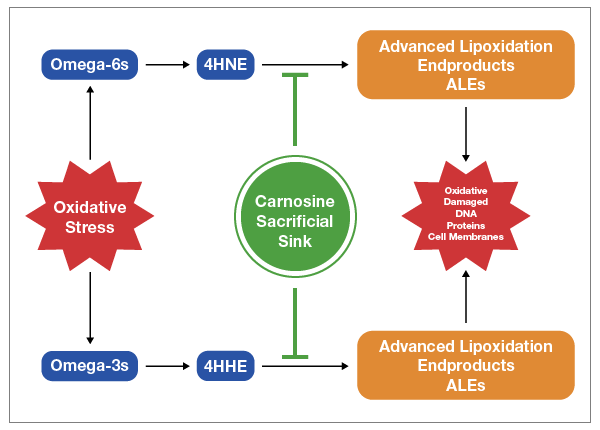
Carnosine is found in meats, and eating animal protein is known to efficiently raise carnosine levels.42 It’s not found in any plant foods. Alternatively, you could use a supplement. In this case, beta-alanine is a superior choice, as it’s the rate limiting amino acid in the formation of carnosine and raises carnosine levels more efficiently. It’s also far less expensive than carnosine.
Summary
Do yourself and your family a favor and embark on a journey of eliminating all seed oils from your diet today to ward off virtually all chronic degenerative diseases. This means avoiding all seed oils, and even fruit oils like olive oil and avocado oils as they are frequently adulterated with cheap seed oils.
Cook with ghee, butter or beef tallow, and avoid all processed foods, as they are typically loaded with seed oils. Also avoid eating in restaurants, as nearly all use massive amounts of seed oils to cook with and put it in their sauces and dressings. Lastly, avoid chicken and pork, and stick to bison and lamb as your primary meat sources.
Sources and References
- 1 Britannica. Lipids
- 2 Nutrients 2023, 15(14), 3129; doi: 10.3390/nu15143129
- 3 Open Oregon. Fatty Acid Types and Food Sources
- 4, 12 Science Direct. Fatty Acids
- 5, 13 Cells. 2021 Jun; 10(6): 1284
- 6 Mount Sinai. EPA
- 7 Heart & Stroke February 6, 2021
- 8 J Political Econ. 1930;38(1):73-85
- 9 Smithsonian Magazine November 23, 2019
- 10 “Profiling Food Consumption in America.” USDA Economic Research Service, Factbook, Chapter 2. ND
- 11 Atkins History
- 14 Oxid Med Cell Longev. 2014;2014: 360438. doi: 10.1155/2014/360438
- 15 Pharmacognosy Review. 2010;4(8):118-126
- 16 Biochemical Journal. 1982;208(1):129-140
- 17 Nephrol Dialysis Transplant. 2001;16(8):1598-1606
- 18 Free Radical Biol Med. 1992;13:341-390
- 19 YouTube, Omega-6 Apocalypse 2, Chris Knobbe August 25, 2021
- 20 Steinberg D, et al. Beyond Cholesterol N Engl J Med 1989; 320:915-924 April 6
- 21 European Heart Journal, June 21, 2020; 41(24): 2313–2330
- 22 Oncology Nurse Advisor July 6, 2018
- 23 Cancer Epidemiology, Biomarkers & Prevention. July 4, 2018
- 24 Free Radic Res. 2015;49(7):827-34
- 25 Photochem Photobiol. 2002 Dec;76(6):657-63
- 26 Exp Dermatol. 2003;12 Suppl 2:18-21
- 27 Renewable Energy. 2018; 126: 403-419
- 28 Int J Mol Sci. 2015;16(6):12871-12890
- 29 The Plan Journal. 2008;54:640-655
- 30 North American Olive Oil Association. The Future of Olive Oil in the United States. March 2019
- 31 Food Safety News April 12, 2022
- 32 Green HS, et al. First report on quality and purity evaluations of avocado oil sold in the US Food Control Volume 116, October 2020, 107328
- 33 Int J Curr Pharm Rev Res. 2011;2(3):145-160
- 34 Applied Sciences. 2019;1 Article no: 1531
- 35 Livestock Production Science. 1998;56:145-156
- 36 Scientific Reports 2016; 6 Article number 21892
- 37 Ecowatch October 8, 2016
- 38 CivilEats December 8, 2014
- 39 BU Today
- 40 Nutrition Data Wild Atlantic Salmon
- 41 Nutrition Data Farmed Atlantic Salmon
- 42 Science Direct, Carnosine; Nutritional Supplements and Metabolic Syndrome
About the author:
Born and raised in the inner city of Chicago, IL, Dr. Joseph Mercola is an osteopathic physician trained in traditional and natural medicine. Board-certified in family medicine, Dr. Mercola served as the chairman of the family medicine department at St. Alexius Medical Center for five years and, in 2012, was granted fellowship status by the American College of Nutrition (ACN).
While in practice in the late 80s, Dr. Mercola realized the drugs he was prescribing to chronically ill patients were not working. By the early 90s, he began exploring the world of natural medicine and soon changed the way he practiced medicine.
In 1997, Dr. Mercola founded Mercola.com, which is now routinely among the top 10 health sites on the Internet. His passion is transforming the traditional medical paradigm in the United States. “The existing medical establishment is responsible for killing and permanently injuring millions of Americans… You want practical health solutions without the hype, and that’s what I offer.”
Visit Mercola.com for more information, or read Dr. Mercola’s full bio and resumé here.
[pro_ad_display_adzone id=”110027″]







